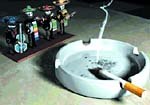TO THE UNINITIATED, it looks most like a model railroad: a ping-pong table-sized board covered in scale-model buildings and roads, with miniature trees and hills giving the appearance of a European countryside. But there are no trains—only an ominous massing of World War II tanks and soldiers along one side of the board matching the force in place at the other end. As the day wears on, the troops are moved slowly up the road, white cotton marking the smoke of an artillery barrage, blackened cotton indicating where the rounds have hit.
The game is Command Decision 3, the most recent in a series of tabletop simulations of World War II designed by Frank Chadwick. World War II gamers, an odd and disparate group including aging veterans and twentysomethings alike, compose a fringe subculture of a fringe hobby. Using plastic models, dice, and elaborate rules, players get together to recreate battles from the Second World War’s European theater. Games can take tens of hours across multiple play sessions to complete. More ambitious groups play out entire operations in which success or failure in one battle has a ripple effect in subsequent games.
The first edition of the game was popular but lean; players flooded the publisher, Games Designers’ Workshop, with suggestions for changes and additions. The second Command Decision was far larger, but also filled with errors and critical omissions when it hit the market. When GDW went bankrupt in 1996, many gamers thought that this might be the end of Command Decision.
They were wrong. The game was saved by, of all things, the Internet.
In the paper-and-dice game community, the received wisdom is that the Internet spells doom for traditional gaming. Combining the flash and visual gratification of computer games with the human interaction once available only from traditional games, Internet-based gaming has taken off in recent years. But many Internet gamers have discovered that circling around a table with dice and a rule book has a visceral appeal that is hard to duplicate via a keyboard and modem. So rather than killing off traditional role-playing and war games, it turns out that the Internet has actually helped them to thrive.
CD Mailer
In the early ’90s, computer programmer Barry Geipel was one of a cadre of WWII experts answering questions and solving problems on the Usenet message board rec.games.miniatures.historical. In the pre-commercial, pre-Web days of the Internet, Usenet was a global conferencing system with thousands of discussion groups and topics. RGMH (as its participants called the group) was a source of conversation about a myriad of war games involving tiny soldiers, from Napoleonic armies to Russian tank divisions.
As the Internet grew and Usenet started to fill up with the arguments and crass advertising that characterize it today, Geipel decided to start an electronic mailing list to discuss game issues. This allowed him to keep the “signal-to-noise ratio” high and keep the focus on the game. In 1993, the CD Mailer was born.
Electronic mailing lists for fringe hobbies and interests are commonplace today, but the CD Mailer was nearly the only one of its kind when it was created. As with many e-lists, its participants quickly developed a sense of community, a connection with and responsibility to one another that went beyond simply sharing gaming tips. CD Mailer subscriber John Sramek calls the list “a town square where we could gather and interact.” After GDW’s demise, this community had its own version of a barn-raising exercise: They built the new version of the game.
Game designer Frank Chadwick, who retained the rights to Command Decision after the GDW bankruptcy, posted early drafts of the version 3 rules to the mailing list, allowing people to download and play-test the new rules with their own groups all around the world. Comments and reactions were posted to the list, where they in turn prompted new observations, critiques, and game rules. So the design of Command Decision 3, rather than reflecting the tablets-from-on-high approach of the previous version, grew directly from the daily interactions between the game players and the game writers. With suggestions and observations filling the list, the distinction between player and writer became increasingly fuzzy.
Seattle war gamer Mark Serafin observes that “the third edition was in large part developed and play-tested by people on the mailer. . . . I think that we would have a third edition even without the mailer. . . . [but] the final product is better than it would have been.”
Open Source gaming
Steve Jackson, owner and CEO of Steve Jackson Games, believes that the online fan base was critical to Command Decision’s revival. “I have heard more than one person opine that GDW’s failure to apprehend the proper use of the Net contributed to their fall,” he says. “They had the kind of enthusiastic but widely spread user base that needed a Net presence to coordinate it.” Steve Jackson Games, publisher of the paper-and-dice role-playing game GURPS and several other dice and card games, enthusiastically embraced the Internet. “We jumped on the Net very early as a communication and support tool for our noncomputer games. I know that it has done a lot for us . . . not just in terms of sales but also in terms of coordinating our writers and editors.”
Every new publication in the GURPS series is play-tested by subscribers to Jackson’s Web site/magazine, Pyramid. Early drafts of the rules are posted, and the writers of the rule books become active participants in electronic discussions about the publication. Jackson is convinced that the the quality of the final work is greatly improved.
The Internet allows traditional gaming to take advantage of the same kinds of forces and attractions that drive the Open Source Software movement. Open Source Software, producer of the operating system Linux and the Web server Apache, is based on the notion that visible source code makes for a better result. The source code for OSS products is made freely available to users, to be read over and altered as needed; OSS adherents claim that this leads to more efficient and bug-free software. Eric S. Raymond, in the seminal article “The Cathedral and the Bazaar,” puts it this way: “Given enough eyeballs, all bugs are shallow.”
In a similar fashion, making early drafts of game rules available to interested players corrects errors far more effectively than any overworked editor could. Game designers can react to critiques and observations, incorporating new perspectives and ideas as the drafts are revised. The end result is more likely to be a game that works well, is fun to play, and omits the various gaps in logic that often bedevil game publishers.
With Command Decision 3 in active use, the CD Mailer has returned to its roots as a resource for ideas. But with a global subscriber base and a strong sense of virtual community, it also is being used now to coordinate massive multi-group campaigns, with dozens of participants around the world playing out the entirety of the Russian Front. “The CD Mailer has become a watering hole for players in these campaigns to both coordinate and to boast of their battlefield victories,” says Geipel. You can hear the happiness in his voice as he savors the irony: Once feared as the death of offline gaming, the Net has turned out instead to be its savior.





